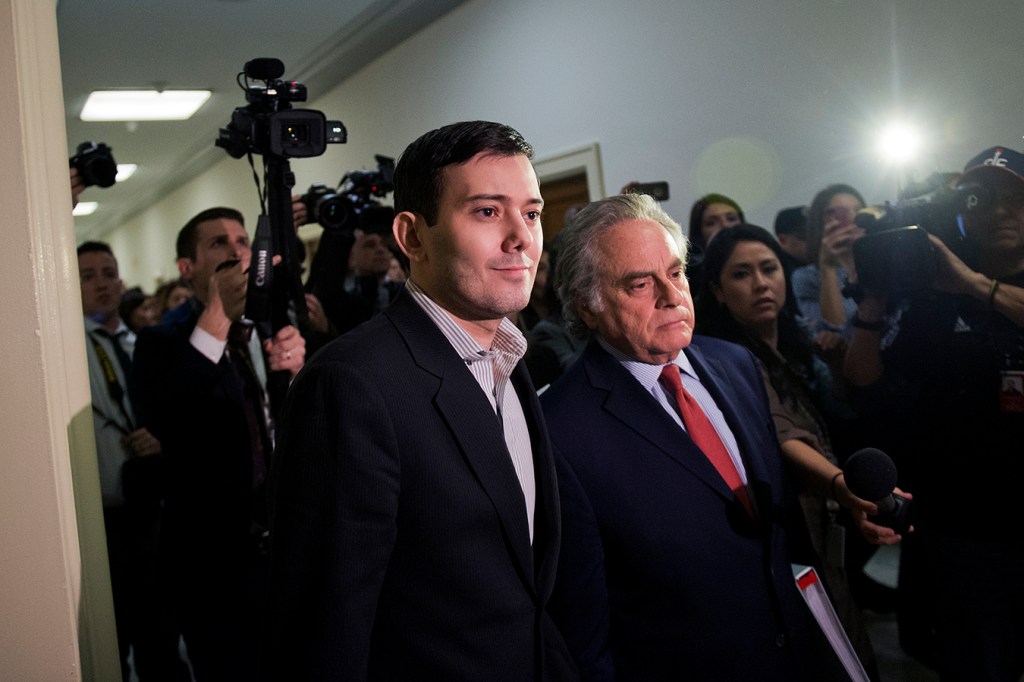It was 2015 when Martin Shkreli, then CEO of Turing Pharmaceuticals and the notorious “pharma bro,” jacked up the cost of the lifesaving drug Daraprim by 5,000 percent. Overnight, its price tag skyrocketed from $13.50 a pill to $750.
The move drew criticism from all corners. Congress hauled Shkreli in for questioning on television. Media outlets shamed the practice. The Pharmaceutical Research and Manufacturers of America (PhRMA), the powerful trade group for branded drugs, distanced itself, saying Turing “does not represent the values of @PhRMA” and kicked off a campaign it described as “more lab coat, less hoodie.”
Shkreli, 35, is now serving a seven-year prison term for securities fraud (unrelated to Daraprim). Turing has renamed itself Vyera Pharmaceuticals.
But Daraprim, which costs pennies to make and is used to treat the parasitic infection toxoplasmosis — which is rare in the United States — still retails for more than $750 per pill, according to drug website GoodRx.com. Vyera did not respond to multiple requests for comment.
The continued high price of the drug is a cautionary tale to those who hope that public shaming of a few “bad actors” can curb escalating drug prices, because the problem is rooted in the market’s underlying financial incentives.
Drug prices are “easy to raise and harder to lower, particularly if there’s no competition,” said Nicholson Price, an assistant professor at the University of Michigan Law School. “The mystery isn’t, ‘Why don’t drug prices go down?’ It’s more, ‘Why don’t they go up more?’”
That’s especially the case with a product like Daraprim, which benefits a relatively small group of people — about 2,000 Americans per year. That means less profit incentive for other companies to develop a competitor that could drive down prices.
Joey Mattingly, an assistant professor at the University of Maryland School of Pharmacy, uses Daraprim as a case study in a university course he teaches on pharmaceutical business strategy, highlighting how the industry functions under current incentives.
“The market sort of sets it up where, if you need it, you have to pay for it,” he said. “A for-profit entity is going to raise the price.”
Branded drugs like Daraprim are more likely to be priced high without a clear justification, noted David Howard, a health economist and professor at Emory University.
Daraprim was first approved by the Food and Drug Administration more than 50 years ago, and the patent has long since expired for both the drug and its active ingredient. But there’s no generic equivalent in the United States.
Even with generic-drug competition, costs don’t always drop. In 2015 alone, 300 generic drugs — off-patent medications, which are typically cheap to make — saw price increases of more than 100 percent, according to a 2016 Government Accountability Office report.
“We don’t have a good model for pricing pharmaceuticals in this country and, as a result, we keep spending a lot more money,” Price said. “We avoid thinking about it, or avoid dealing with it, and as a result things get more problematic.”
As prices climb, Vyera has followed what has become a familiar pharmaceutical playbook to shift attention and costs, launching what it calls the Daraprim Direct program.
Commercially insured patients can get a company-sponsored coupon that guarantees they’ll pay no more than $10 out-of-pocket. Uninsured patients at 500 percent or less of the federal poverty level — about $82,300 for a family of two — won’t pay anything.
People with Medicare Part D coverage can apply for copay assistance from an “independent charitable foundation” to which Vyera has donated money. This option is listed on the Daraprim Direct website. Technically, Medicare beneficiaries cannot use company coupons, but many drug companies skirt that regulation by sending assistance through a separate intermediary — such as an independent charity. It’s common enough that the practice has recently come under federal scrutiny.
Critics are quick to point out that such programs — often deployed for high-priced drugs — may enable patient access but do nothing to address overall expense. Private insurers, Medicare or Medicaid must pay the tab, whether through increased premiums or strained public health budgets.
On average, Medicaid programs in 2017 paid $35,556.48 per Daraprim prescription, according to a Kaiser Health News analysis of federal data covering that year’s first three quarters.
That figure doesn’t account for any rebates state Medicaid programs likely receive from Vyera, which is undisclosed proprietary information. In Massachusetts, those deals mean the state’s net costs for Daraprim have remained largely unchanged since 2014, though the price tag is 75 times what it was, said a spokeswoman for the agency’s Executive Office of Health and Human Services.
But states have variable negotiating leverage and skills in pressing for discounts. And paying for high-cost drugs — especially those without a competitor — remains a serious challenge, she said.
Generally, Medicaid likely pays hundreds of dollars per Daraprim pill, said Matt Salo, executive director of the National Association of Medicaid Directors. A standard starting dose of two to three pills per day lasts one to three weeks. And that’s likely to generate costs much higher than they were before Shkreli started selling Daraprim.
KHN data correspondent Sydney Lupkin contributed to this report.
Note: To determine what Medicaid paid for Daraprim, Kaiser Health News used data made public by the Centers for Medicare & Medicaid Services. This figure represents a weighted average of Medicaid payments per prescription, across various strengths, package sizes, routes and labels. It does not include drug versions (represented by National Drug Codes) with fewer than 11 prescription fills per quarter.
KFF Health News' coverage of prescription drug development, costs and pricing is supported in part by the Laura and John Arnold Foundation.







